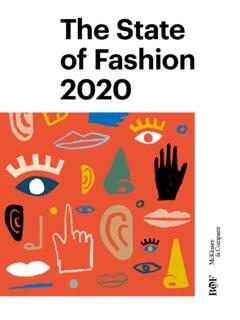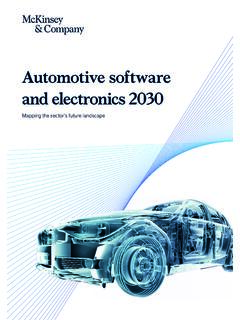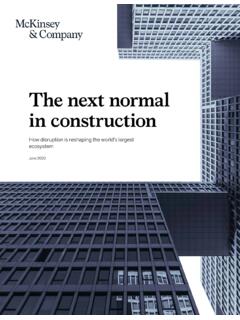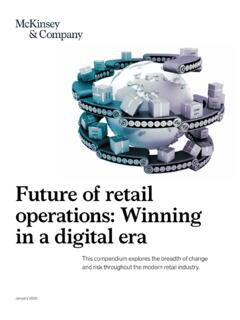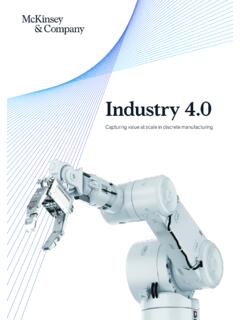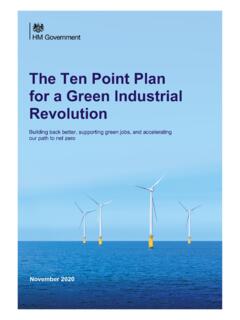Transcription of The 2020 McKinsey Global Payments Report
1 October 2020 Global Banking PracticeThe 2020 McKinsey Global Payments Report2 The 2020 McKinsey Global Payments ReportThe public health crisis triggered by COVID-19 has had an impact on nearly all aspects of daily life for people across the globe, and has put the world economy on an uncertain footing. For the Payments industry, the pandemic and its consequences have accelerated a series of existing trends in both consumer and business behaviors, and introduced new developments, such as a restructuring of both supply chains and cross-border trade. Ongoing shifts toward e-commerce, digital Payments (including contactless), instant Payments , and cash displacement have all been significantly boosted in the past six months.
2 And while a degree of reversion to past behavior is likely for some of these shifts, the overall trajectory for these trends has received a strong push forward. Overall, the crisis is compressing a half-decade s worth of change into less than one year and in areas that are typically slow to evolve: customer behavior, economic models, and Payments operating models. As with most structural shifts, challenges will inevitably impact of the crisis has not been consistent across sectors or geographies, of course. Travel and entertainment, which had been among the most advanced e-commerce sectors, was hit particularly hard and faces an uncertain path to recovery.
3 Payments providers in regions that have lagged in digitization, meanwhile, in many cases possess greater potential for revenue increases in the new environment. On the other hand, a protracted period of low interest rates, which began before the current crisis, will pressure Payments revenues, as will a persistent slowdown in economic is the context in which we release our annual Report on the Global Payments industry. As always, these insights are informed by McKinsey s Global Payments Map and by continuing dialogue with practitioners throughout the Payments ecosystem.
4 Given the impact of the changes and challenges in 2020, however, we are taking a different lens to our analysis, focusing more on the current moment and on the future, than on examining past growth. Our first chapter briefly tells the story of 2019 a solid year with broad-based revenue growth but focuses primarily on current developments and takes a forward-looking view of the Payments landscape. It also details the actions we believe Payments providers will need to take to weather the pandemic and position themselves for the next normal. Our now-cast analysis of 2020 paints a contrast between the first and second halves of the year namely, an estimated 22 percent Payments revenue decline in the first half will be softened somewhat by stronger performance in the second half.
5 Still, we expect full-year 2020 Global Payments revenue to be roughly 7 percent lower than it was in 2019 a $140-billion decline roughly equal to recent years annual gains, and 11 to 13 percent below our pre-pandemic projection. Beyond this, in some countries and segments, the likely sustained increase in digital penetration could result in a recovery of revenue pools to levels matching our pre-COVID-19 expectations for following chapters, we explore four areas of Payments we consider critical to achieving success in the context of accelerated change. Like many aspects of Payments , the merchant-acquiring business was already undergoing significant transformation.
6 Consolidation had driven scale economy imperatives, and non-bank market entrants were gaining inroads with underserved verticals. Our experts detail the need to redefine acquiring offerings to encompass a full suite of value-added services extending well beyond Payments settlement including fraud controls and cart optimization for the fast- growing e-commerce segment. In a separate chapter we look at the specific opportunity for small- and medium-size enterprises, a segment that has historically been expensive to serve for large incumbents, but which has been the focus of many fintech attackers and is well overdue for a closer look.
7 Supply chain finance has long been considered to be a source of untapped value, but unlike other Payments sectors, has struggled to develop enough momentum to address its structural challenges . Foreword3 The 2020 McKinsey Global Payments ReportAlessio Botta Leader, Europe Payments PracticePhil Bruno Co-leader, North America Payments PracticeReet Chaudhuri Leader, Asia Payments PracticeMarie-Claude Nadeau Co-leader, North America Payments PracticeGustavo Tayar Leader, Latin America Payments PracticeCarlos Trascasa Leader, Global Payments PracticeGiven an expected increased focus on working capital, a step change in digital adoption at scale.
8 And the potential geographic re-shuffling of roughly $4 trillion of cross-border supply chain spending in the next five years the value embedded in supply-chain finance will become even more attractive. The question is whether it will be enough to spur a long-anticipated , in this overview of Global Payments , we look at a challenge many established Payments providers are facing the need to transform the operating model to meet the growing imperatives for efficiency, scale, modularity ( , Payments -as-a-Service), and Global interoperability. With many banks likely unwilling to commit the hundreds of millions of investment dollars needed to modernize existing Payments infrastructure, we outline various paths worth considering before more focused players can establish an insurmountable hope you find the insights in these pages thought-provoking and valuable as you navigate these uncertain times.
9 McKinsey s Global Banking Practice leaders would like to thank the following colleagues for their contributions to this Report : Maria Albonico, Fabio Cristofoletti, Vaibhav Dayal, Olivier Denecker, Nunzio Digiacomo, Puneet Dikshit, Alberto Farroni, Diana Goldshtein, Reinhard H ll, Reema Jain, Baanee Luthra, Tobias Lundberg, Yaniv Lushinsky, Pavan Kumar Masanam, Albion Murati, Tamas Nagy, Marc Niederkorn, Nikki Shah, Lit Hau Tan, and Jonathan Zell. 4 The 2020 McKinsey Global Payments ReportFor the Global Payments sector, the events of 2020 have reset expectations and significantly accelerated several existing trends.
10 The public health crisis and its many repercussions among them, government measures to protect citizens and rapid changes in consumer behavior changed the operating environment for businesses, large and small, worldwide. For the Payments sector, Global revenues declined by an estimated 22 percent in the first six months of the year compared to the same period in 2019. We expect revenues to recover (only to a degree) in the second half of 2020, ending 7 percent lower than full-year 2019. Over the past several years, Payments revenues had grown by roughly 7 percent annually, which means this crisis leaves revenues 11 to 13 percent below our prepandemic revenue projection for the impact of COVID-19 on the operating environment, we are diverging from our usual approach of delivering perspectives on the current year s Global Payments landscape relative to the prior year.


